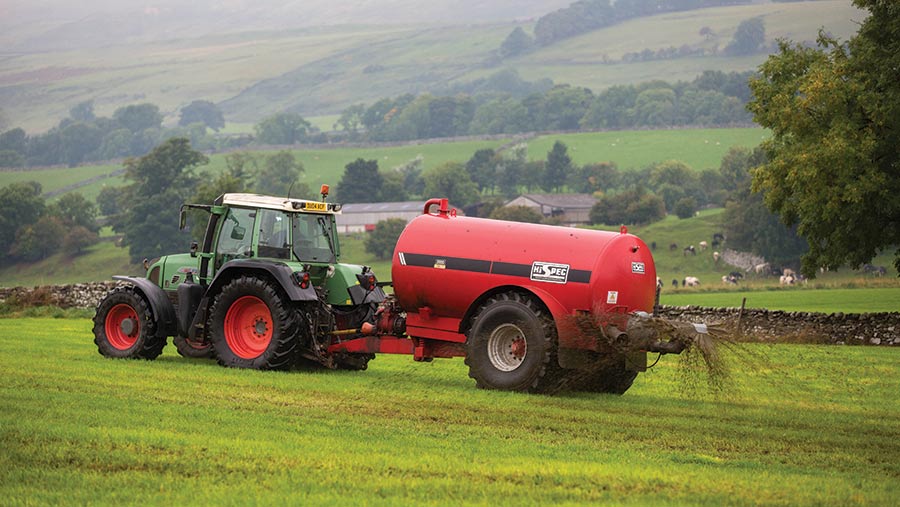Guide to fertiliser terminology and spreading equipment

Applying fertiliser and manure is a key part of good grassland management.
However, with farmers under increasing environmental pressure to cut water and atmospheric pollution, we take a look at how farmers can identify:
- which fertiliser to chose
- which machinery to use for application
- and how to use risk maps to cut risks.
See also: Safe storage and spreading of slurry and fertiliser
Step one: Identifying which manure or fertiliser to use
Organic fertiliser (livestock manure) has additional benefits to its nutrient value – it builds soil organic matter, increasing water-holding capacity and decreasing the risk of leaching.
However, it can cause grass taint, releases nutrients slowly, smells, and has disease implications.
Manures vary in the amount of available nitrogen (N) – only about 10% of N is immediately available from solid straw-based manure and digestate.
With cattle slurry, this is about 25%; pig slurry about 40%; poultry manure about 25% plus around 15% uric acid – making poultry manure very high in available N. Whole digestate has about 95% available N.
Inorganic (manufactured) fertiliser has very accurate nutrient content, is quick release and easy to apply, but it is more expensive, can scorch crops, and due to its concentrated form can quickly cause major pollution and nutrient losses.
Urea is slower release than AN so needs to be applied earlier and is therefore vulnerable to leaching.
Look at the bag label to identify nutrient values and the form in which N is present.
Labels will also display the weight, chemical description, hazard sign, country of origin, storage and handling guidance, emergency contact details and EC approval.
Terminology:
Straight – contains only one nutrient:
AN 34.5:0:0 spread at 100kg/ha = 34.5kg/ha of plant available nitrogen.
Urea – 46:0:0
Super phosphate – 0:21:0
Triple super phosphate – 0:46:0
Muriate of potash – 0:0:60
Compound – contains two or more nutrients.
E.g. 20:10:10 spread at 100kg/ha = 20kg N, 10kg P and 10kg K/ha.
Blended compound – two or more straight fertilisers, mixed.
May affect spread characteristics
Complex compound – each particle contains all the nutrients. More accurate spreading.
Note: The numbers relate to the nitrogen: phosphorus (P) : potassium (K) quantities of the product.
Step two: Which spreading machinery to use?
Accurate and even application of fertilisers and manure is essential to maximise crop yield and quality and prevent nutrient losses. Whatever equipment you use, calibrate it every year and check spread patterns.
Solid manures:
- Rotospreader – Throws muck out of a long side opening. Cheap and light but small capacity and inaccurate
- Dual spreader – Throws muck out of a narrow side opening. Accurate and large capacity, can spread liquids or solids, but expensive
- Rear-discharge spreader – Throws muck out of the rear opening. Accurate and quick to load, but heavy and expensive.
Slurry:
- Splash plate – sprays slurry through the air. Cheap and simple but very high ammonia losses of up to 80%. Can cause crop taint
- Dribble bar – places slurry on the surface, reducing nutrient losses, but slow and expensive
- Trailing shoe – creates a shallow slit for slurry, which helps absorb nutrients into the soil. Narrow, therefore slow
- Injection – injects slurry into the soil. Best for reducing nutrient losses, no crop taint, but more horsepower needed
- Umbilical systems – pumps slurry from storage facility using a high-pressure pump to the tractor-mounted applicator. It reduces soil compaction and travelling time, but potential for double application on headlands and leaking joints.
Inorganic fertiliser:
- Spinning disc – spreads granules in a wide arc from horizontal rotating discs. Easy to use, large capacity, but inaccurate at wide widths
- Oscillating spout – spreads granules through a tube that swings from one side to the other. Cheap, lightweight, but small capacity and narrow widths
- Pneumatic – pumps granules out to a boom attached to the tank, similar to a sprayer. Very accurate, section control available, but expensive
- Liquid – pumps liquid to a spray boom attached to the tank. Very accurate, quick nutrient availability, but slow and can scorch crops.
Step three: Using risk maps, nutrient management plans and record keeping
Everyone who spreads organic manures should have a risk map of their farm, showing all surface water within 10m of their land plus springs, wells and boreholes within 50m. Risk factors include slope, weather and soil conditions, ground cover, proximity to water and presence of land drains.
Fields and areas should be colour-coded according to risk:
- Red: don’t spread;
- Orange: avoid in winter/dry summer/when compacted;
- Yellow: can spread throughout the year subject to ground conditions but restricted rates in winter;
- Green: can spread throughout the year.
Nutrient management plans are required by most assurance schemes. Keep a record of all fertiliser and organic manure applications (including from grazing livestock) and take soil samples from each field every three to five years (recommended).
When planning applications, consider nutrient availability in the soil (based on soil analysis or RB209 guidance and previous cropping) and work out crop requirements for the time of year. Analyse manures or consult RB209 for estimated nutrient content, and work out how much inorganic fertiliser is required as a top-up to meet crop needs. Consult the risk map before application.
Records must be updated within one week of sowing a crop and spreading organic or inorganic fertiliser. You must keep all records for at least five years.
Course details

The Lantra accredited course is the first of its kind for fertiliser and manure application. It was organised by Greenway Training with help from Wessex Water and delivered by Chris Padfield from Hawthorn Training Services. See details on the Lantra website.
